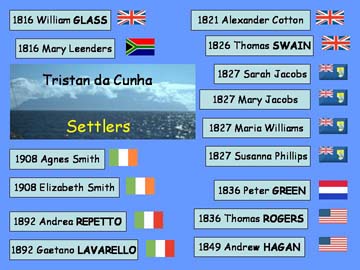A guide to the Tristan da Cunha History Pages : |
||||
Discovery & Settlement 1506 - 1817 |
Including Tristao da Cunha, American Interlude and British Garrison |
|||
A Growing Community 1817 - 1853 |
A successful trading settlement |
|||
Isolation & Hardship 1853 - 1942 |
Coping with isolation and tragedies |
|||
Joining the Modern World 1942 - 1961 |
Including a wartime naval station and a fishing enterprise |
|||
Volcanic Interlude 1961-1963 |
Volcanic Eruption, Evacuation and re-settlement |
|||
Rebuilding 1963 onwards |
We hope to develop this page, but you will also find much modern history elsewhere on the website and in the Tristan da Cunha Newsletter |
|||
But first, read the general introduction to Tristan da Cunha's History..... |
||||
Introduction to Tristan's History |
 |
||||
The Settlers |
|||||
Flags |
